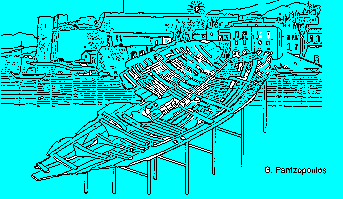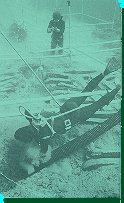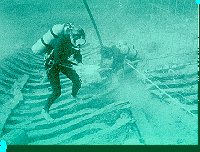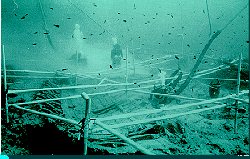
The Recovery
Work begins
 Work began with permission from the Cyprus Department of Antiquities. There was a large barge anchored on the surface right above the shipwreck from where operations were carried out. The archaeologists and divers were amateurs, so every possible precaution had to be taken. Equipment was scholastically checked. A short medical examination before every dive was considered essential. Divers went down twice every day - once in the morning and once in the afternoon. Six divers took part each time, working in pairs, one watching the other for extra security. Each dive took no more than 40 minutes. Time was checked by those on the barge who sent coded signals to divers in the deep. A telephone box was immersed in the water from the very beginning - a device that was used for the first time in underwater exploration. This was conceived by Katsev and his wife. Atmospheric air was continuously piped into the perspex glass inverted hemisphere by the people on the barge so that in case of emergency a diver could swim, get inside the inverted hemisphere and talk to those on the surface with the help of a closed circuit telephone.
Work began with permission from the Cyprus Department of Antiquities. There was a large barge anchored on the surface right above the shipwreck from where operations were carried out. The archaeologists and divers were amateurs, so every possible precaution had to be taken. Equipment was scholastically checked. A short medical examination before every dive was considered essential. Divers went down twice every day - once in the morning and once in the afternoon. Six divers took part each time, working in pairs, one watching the other for extra security. Each dive took no more than 40 minutes. Time was checked by those on the barge who sent coded signals to divers in the deep. A telephone box was immersed in the water from the very beginning - a device that was used for the first time in underwater exploration. This was conceived by Katsev and his wife. Atmospheric air was continuously piped into the perspex glass inverted hemisphere by the people on the barge so that in case of emergency a diver could swim, get inside the inverted hemisphere and talk to those on the surface with the help of a closed circuit telephone.
It was observed right from the start that the bottom of the sea was covered by a thick layer of seaweed which had to be removed before commencement of operations. But roots hold fast, so a perforated air-duct was prepared. The diver - archaeologist would push the pipe into the mud under the roots. The pressure of the air escaping through the holes of the air-duct loosened the roots, which could then be removed without difficulty.
 A second stage followed in which the main tool in the underwater exploration was a thick plastic pipe like those used for irrigation. It works like an elevator or vacuum cleaner. It sucks the mud which has been liberated by the air-duct in the previous stage and carries it away from the site of exploration. The operator must be very careful and never allow the intake aperture of the pipe to come into contact with the seabed.
A second stage followed in which the main tool in the underwater exploration was a thick plastic pipe like those used for irrigation. It works like an elevator or vacuum cleaner. It sucks the mud which has been liberated by the air-duct in the previous stage and carries it away from the site of exploration. The operator must be very careful and never allow the intake aperture of the pipe to come into contact with the seabed.
Wherever archaeological research takes place, whether on the ground or at the bottom of the sea, it always presupposes method, accuracy and recording of all data. For this reason the site is always marked out. In the case of the Kyrenia ship the archaeologists constructed a large plastic network. Each square piece was 3 X 3 wide and the whole mesh covered an area of 10 X 28 metres. Now the position of each article that was found could be defined. The amphorae began to be counted. The site had to be mapped out, quickly and effectively as well. Time down there was valuable in many ways. Stereophotography was used, with the photographer taking pictures twice a day, as if flying over the wreck with two special cameras at the edge of his rod. Stereophotography offers a third dimension to objects, making their size quite clear.
When every detail had been photographed, we began to carry the amphorae to the surface. 404 amphorae, after remaining in the dark depths of the sea for 22 centuries, were hauled up to the surface.
The pointed-bottom amphorae used to be placed in suitable openings in a ship's hold or damp basements of houses and shops which kept their contents cool. It is estimated that these amphorae could hold as many as 40 kilos of wine. Inside the amphorae we found wonderfully preserved almonds. The 10.000 almonds were originally kept in sacks but in time the amphorae became the homes of octopuses which carried the nuts there with their tentacles.
After careful excavation stretching over two summers, archaeologists came face to face with the hull of the sunken ship. Mud and sand had preserved it there for 2000 years. In fact it was to date the best-preserved skeleton of an ancient ship. And, as the Kyrenia ship was a rare archaeological treasure, its recovery was considered necessary regardless of expense or labour.
After being numbered, the various pieces were put on large iron discs, on which they were to be raised to the surface. Protective sheets were placed over the priceless wood. The ship could not be raised as a whole because the wood had absorbed a lot of water and was not a solid mass any longer. The pieces of wood looked liked soaked bread or an old worn-out sponge that was now 75% water. The invaluable load finally reached the land and was subsequently laid in the courtyard of Kyrenia castle. The archaeologists patiently, persistently and methodically washed the timber in a makeshift pool. A total of five tons of wood was raised from the sea, which. had to be rinsed well in order to get rid of salt and sand. An old room in the castle was turned into a special area where the valuable wood from the oldest ship and the first to be raised from the deep would remain on deep discs until the time when work for its chemical preservation would begin. What had been preserved for 22 centuries by the damp and muddy depth should not be destroyed by human clumsiness or wrong manipulation.
 While the cleaning process was taking place at the Castle, some exciting information came to light: the age of the ship was determined by using the "carbon 14" method. The almonds which the ship was carrying had been picked around 288 B.C while much of the ship's timber was 100 years older, i.e the trees had been cut down around 388 B.C. Some of the ship's wood was worm-eaten from old times. As the archaeologists decided to restore the ancient ship using the old worm-eaten wood, a detailed diagram of each piece in actual size was prepared. Everything had to be carefully studied and every detail had to be put on record before the hazardous phase of chemical preservation of the wood began. Every piece had to be photographed and thousands of diagrams made. This work was to last for a couple of years. And it was only by delving through the plethora of information that the shipmaker could termine the type of this ancient commercial ship, since, with the passing of time, many of the ship's pieces had lost their curvature, weighted down in the depths of the sea by the ship's cargo.
While the cleaning process was taking place at the Castle, some exciting information came to light: the age of the ship was determined by using the "carbon 14" method. The almonds which the ship was carrying had been picked around 288 B.C while much of the ship's timber was 100 years older, i.e the trees had been cut down around 388 B.C. Some of the ship's wood was worm-eaten from old times. As the archaeologists decided to restore the ancient ship using the old worm-eaten wood, a detailed diagram of each piece in actual size was prepared. Everything had to be carefully studied and every detail had to be put on record before the hazardous phase of chemical preservation of the wood began. Every piece had to be photographed and thousands of diagrams made. This work was to last for a couple of years. And it was only by delving through the plethora of information that the shipmaker could termine the type of this ancient commercial ship, since, with the passing of time, many of the ship's pieces had lost their curvature, weighted down in the depths of the sea by the ship's cargo.
From the script of the documentary
"With the captain and three sailors - the ancient ship of' Kyrenia" Text by SUSAN WOMER KATSEV
 Go back to the previous page
Go back to the previous page
Monday, May 27, 1996 11:59:56 PM


 Work began with permission from the Cyprus Department of Antiquities. There was a large barge anchored on the surface right above the shipwreck from where operations were carried out. The archaeologists and divers were amateurs, so every possible precaution had to be taken. Equipment was scholastically checked. A short medical examination before every dive was considered essential. Divers went down twice every day - once in the morning and once in the afternoon. Six divers took part each time, working in pairs, one watching the other for extra security. Each dive took no more than 40 minutes. Time was checked by those on the barge who sent coded signals to divers in the deep. A telephone box was immersed in the water from the very beginning - a device that was used for the first time in underwater exploration. This was conceived by Katsev and his wife. Atmospheric air was continuously piped into the perspex glass inverted hemisphere by the people on the barge so that in case of emergency a diver could swim, get inside the inverted hemisphere and talk to those on the surface with the help of a closed circuit telephone.
Work began with permission from the Cyprus Department of Antiquities. There was a large barge anchored on the surface right above the shipwreck from where operations were carried out. The archaeologists and divers were amateurs, so every possible precaution had to be taken. Equipment was scholastically checked. A short medical examination before every dive was considered essential. Divers went down twice every day - once in the morning and once in the afternoon. Six divers took part each time, working in pairs, one watching the other for extra security. Each dive took no more than 40 minutes. Time was checked by those on the barge who sent coded signals to divers in the deep. A telephone box was immersed in the water from the very beginning - a device that was used for the first time in underwater exploration. This was conceived by Katsev and his wife. Atmospheric air was continuously piped into the perspex glass inverted hemisphere by the people on the barge so that in case of emergency a diver could swim, get inside the inverted hemisphere and talk to those on the surface with the help of a closed circuit telephone. A second stage followed in which the main tool in the underwater exploration was a thick plastic pipe like those used for irrigation. It works like an elevator or vacuum cleaner. It sucks the mud which has been liberated by the air-duct in the previous stage and carries it away from the site of exploration. The operator must be very careful and never allow the intake aperture of the pipe to come into contact with the seabed.
A second stage followed in which the main tool in the underwater exploration was a thick plastic pipe like those used for irrigation. It works like an elevator or vacuum cleaner. It sucks the mud which has been liberated by the air-duct in the previous stage and carries it away from the site of exploration. The operator must be very careful and never allow the intake aperture of the pipe to come into contact with the seabed. While the cleaning process was taking place at the Castle, some exciting information came to light: the age of the ship was determined by using the "carbon 14" method. The almonds which the ship was carrying had been picked around 288 B.C while much of the ship's timber was 100 years older, i.e the trees had been cut down around 388 B.C. Some of the ship's wood was worm-eaten from old times. As the archaeologists decided to restore the ancient ship using the old worm-eaten wood, a detailed diagram of each piece in actual size was prepared. Everything had to be carefully studied and every detail had to be put on record before the hazardous phase of chemical preservation of the wood began. Every piece had to be photographed and thousands of diagrams made. This work was to last for a couple of years. And it was only by delving through the plethora of information that the shipmaker could termine the type of this ancient commercial ship, since, with the passing of time, many of the ship's pieces had lost their curvature, weighted down in the depths of the sea by the ship's cargo.
While the cleaning process was taking place at the Castle, some exciting information came to light: the age of the ship was determined by using the "carbon 14" method. The almonds which the ship was carrying had been picked around 288 B.C while much of the ship's timber was 100 years older, i.e the trees had been cut down around 388 B.C. Some of the ship's wood was worm-eaten from old times. As the archaeologists decided to restore the ancient ship using the old worm-eaten wood, a detailed diagram of each piece in actual size was prepared. Everything had to be carefully studied and every detail had to be put on record before the hazardous phase of chemical preservation of the wood began. Every piece had to be photographed and thousands of diagrams made. This work was to last for a couple of years. And it was only by delving through the plethora of information that the shipmaker could termine the type of this ancient commercial ship, since, with the passing of time, many of the ship's pieces had lost their curvature, weighted down in the depths of the sea by the ship's cargo.
 Go back to the previous page
Go back to the previous page